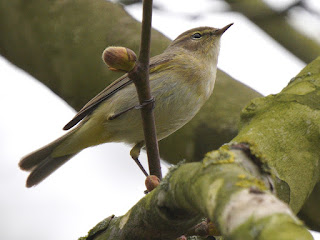One of the Grey Heron parents was on the nest alone, looking quite relaxed for a change.
This was because both the young ones had climbed out of the nest for the first time, and were exploring the tree. This one was only partly visible below the nest, and the other one was almost completely hidden and isn't shown here. The final five seconds, taken two hours later, shows that they managed to get back in, as they must because their parents will only feed them when they are in the nest.
This heron on the island, still partly in juvenile plumage, is not the one that was hatched here last year, which was also on the island (and was shown in the blog the day before yesterday). It has probably flown in from Regent's Park along with an older bird to show it the way.
There's still no sign of hatching at the Great Crested Grebes' nest opposite Peter Pan ...
... and the one under the willow by the bridge has only been recently started. I saw the grebe shown here in the water catch quite a small fish less than two inches long, an encouraging sign for the feeding of the young as their parents only know how to give them whole fish.
I haven't seen any of the three dark Mallard drakes for several months, but today one of them was at the Dell restaurant.
Not all the Common Gulls have left yet. There was one at Peter Pan.
And the Redwings were still on the Parade Ground, though now that the weather has warmed up they will be off at any moment.
A Chiffchaff was singing at the east end of the Lido ...
... and so were several Greenfinches in the treetops near the bridge.
In the Flower Walk a pair of Long-Tailed Tits bounced around in the bushes ...
... and the confident Robin sidled out of a flower bed and flew up to take several pine nuts from my hand.
Three good pictures from our anonymous contributor: a Treecreeper near the Speke obelisk...
...a Goldfinch pecking bits out of a leaf bud ...
...and what we are pretty sure is a female Siskin, though it's hard to be sure with a frontal shot that doesn't show the wings, and it flew off before another picture could be taken. Update: Conehead 54 confirmed this identification.
The new reed bed on the Long Water is being made by dredging up ground from the bottom of the lake and dumping it on the shore till it's just below water level. This is done to avoid adding ordinary soil to the lake, which would leach nitrates and phosphates into the water and encourage the growth of algae.
Finally, a remarkable shot from Finland by Jukka Tiippana. Two Dippers have managed to overwinter in Helsinki, on the Vanhakaupunki rapids in the river Vantaa. They were remarkably skilled at finding bits of unfrozen water to fish in. Normally the local Dippers migrate to Norway, where even on the relatively mild southwestern coast it freezes in winter, but much less severely than in Finland.















What a handsome bird, the Dipper! It is said here that their presence means any water stream they are near to is pure and unpolluted.
ReplyDeleteSometimes I think we underestimate how much courage it takes to be a bird. Imagine being all cozy and warm in your nest, and then being encouraged, or forced, to leave it and take your first unsure steps in an alien and hostile world.
The young herons were longing to get out of their nest. They were becoming more and more restless, and have certainly left voluntarily to enjoy exploring the brand new world. They are still being fed in the nest, and the agonising moment when they are cast adrift and have to fend for themselves is still to come.
DeleteDefinitely a female Siskin, Ralph. They must be passing through now as we had 3 males & a female in a small alder in Osterley Park on Saturday. Didn't see any there in the winter.
ReplyDeleteThanks for the confirmation.
Delete